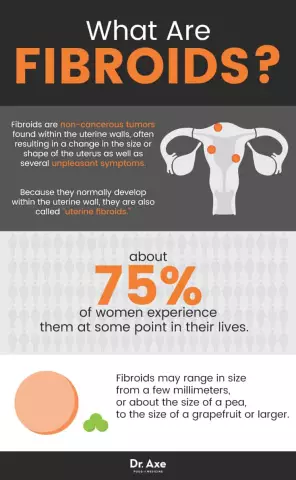- Author Rachel Wainwright [email protected].
- Public 2023-12-15 07:39.
- Last modified 2025-11-02 20:14.
9 myths about uterine fibroids
Uterine fibroids are one of the most common gynecological diseases. Among women aged 35-50 years, up to 70% suffer from it. It is impossible to conduct accurate statistical studies, since in almost half of the cases, the disease is asymptomatic and is discovered by chance during routine examinations.
Until the end of the 20th century, fibroids were considered a dangerous pathology requiring radical treatment. Over the past decades, ideas about the disease have changed, but still not only patients, but also many doctors share the misconceptions about uterine fibroids.

Source: depositphotos.com
Myoma is a precursor to malignant neoplasm
Until recently, the main argument in favor of surgical treatment of fibroids was the fear that a benign tumor would degenerate into cancer. It has been established that this does not happen. Myoma does not become malignant, its presence does not stimulate the development of other types of cancer (including tumors of the reproductive system). That is why the histological examination of the cells of myomatous nodes, which is often prescribed by doctors, is not an obligatory diagnostic procedure.
Myoma appears due to hormonal disorders
Each myomatous node develops from a separate cell of the muscle tissue of the uterus (myometrium). The process is often observed in women with an unstable hormonal background, but a direct link between hormonal disorders and the formation of fibroids has not been identified.
Myoma must be removed
Having found a uterine fibroid in a patient, the doctor may strongly advise to carry out the so-called curettage. The prescription is usually motivated by the fact that this procedure will not only save the patient from myomatous nodes, but will also clarify the cause of their appearance. In fact, the fibroid does not need to be removed immediately.
As for the curettage procedure, it is carried out according to strict indications, among which the presence of fibroids is not included. Most often this is done to assess the state of the endometrium in case of irregular bleeding, the cause of which cannot be established in another way.
Myoma cannot be left without active treatment
According to modern concepts, the presence of small myomatous nodes that do not provoke the appearance of unpleasant symptoms (pain, profuse bleeding, a feeling of squeezing of internal organs, etc.) does not require medical intervention at all. The exception is planning pregnancy, however, in such a situation, a detailed examination is often required, but not treatment.
Myoma refers to neoplasms, the growth of which cannot be predicted. The tumor can maintain a constant size for years and even shrink. It is known for sure: active growth of fibroids occurs only in women of reproductive age; after the onset of menopause, it completely stops. For most patients, radical interventions can do more harm than good.
Patients with fibroids should not sunbathe and go to the bathhouse
There is no scientific evidence to support this statement. True, it does not follow from this that women with uterine fibroids can abuse bath procedures or sunbathing, because these actions are harmful in any case, even if there are no fibroids.
The presence of fibroids does not require either adherence to a special diet or a sharp change in lifestyle. A balanced diet, moderate physical activity, and reasonable alternation of work and rest are usually sufficient to maintain an acceptable level of health.
Myoma leads to infertility
The presence of myomatous nodes does not interfere with getting pregnant, but it can complicate the bearing of the fetus. This usually happens when the nodes grow inside the uterine cavity or severely deform its walls.
Sometimes fibroids are found already during pregnancy. Moreover, IVF is often carried out despite the presence of myomatous nodes. If a tumor is detected before conception (during a routine examination), it is important to consult a qualified specialist. The fact is that the removal of nodes during pregnancy planning carries the risk of subsequent ingrowth of the placenta or rupture of the uterine wall. The doctor must assess this likelihood and propose a solution that is safest for the woman and her unborn child.
Most accurately, the size of the fibroid is determined by ultrasound
During ultrasound examination, the object is visible only in one plane. The myomatous node usually has an irregular shape, resembling a gnarled potato, as a result of which it appears distorted on ultrasound, and this often causes errors in assessing the size of the tumor or, even worse, the rate of its growth.
To understand how myoma actually develops, it is necessary to do an MRI, fix the state of the tumor in 2-3 positions and repeat the procedure after a few months. This is the only way to obtain reliable data on the rate of node growth and to decide on the need and methods of treatment.

Source: treatment-online.com.ua
Fibroids can be cured with herbs
Today, there are many herbal preparations and dietary supplements on the market that supposedly help in the resorption of myoma nodes. Unfortunately, this treatment is a waste of time and money.
A fibroid is an area of altered (compacted) muscle tissue. No folk remedies can change her condition. All cases of successful "resorption", which are reported by "healed" women, in fact, turn out to be the result of a natural cessation of fibroid growth after menopause.
EMA treatment of fibroids is dangerous to health
The method of uterine artery embolization (UAE) is based on the reduction of blood flow to the tumor, which disrupts the process of its nutrition. Today it is the most effective and safest way to fight a tumor. The procedure is performed on an outpatient basis, does not require general anesthesia and almost does not injure the patient.
Until recently, it was believed that UAE can lead to infertility and therefore is indicated only for those women who no longer plan to become pregnant. Clinical studies have shown that the procedure does not affect the subsequent conception and bearing of the fetus.
Uterine fibroids are such a common pathology that the risk of its occurrence is high for every woman. Experts believe that the likelihood of developing the disease can be reduced by regular sex life, refusal of abortions, and maintaining good physical shape. For preventive purposes, it is recommended to visit a gynecologist at least twice a year and once a year undergo an ultrasound scan of the pelvic organs. When a fibroid is detected, you should not panic: in most cases, you should only monitor the state of the tumor. It is important to understand that not all doctors timely update the knowledge gained at the university (sometimes for quite a long time), and therefore do not share modern ideas about the nature and methods of treating fibroids. If the patient is frightened by the rapid growth of nodes,insist on optional diagnostic procedures or recommend urgent surgical intervention with good general health, it makes sense to seek additional advice from other specialists.
YouTube video related to the article:

Maria Kulkes Medical journalist About the author
Education: First Moscow State Medical University named after I. M. Sechenov, specialty "General Medicine".
Found a mistake in the text? Select it and press Ctrl + Enter.






